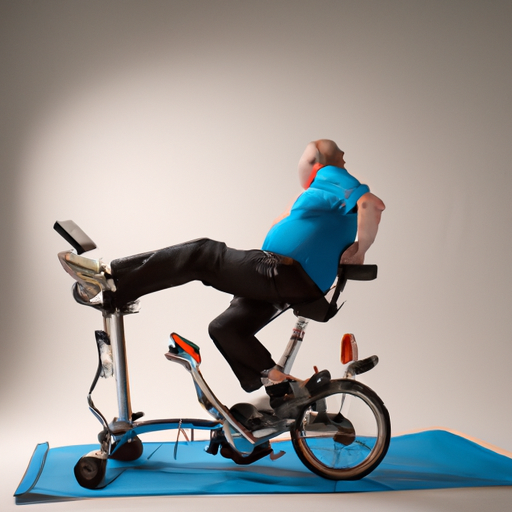If you’ve ever wondered about the distinction between a recumbent and an upright bike, look no further! This article will shed light on the dissimilarities between these two popular exercise machines. Whether you’re a fitness enthusiast seeking the perfect ride or simply curious about expanding your knowledge, understanding the disparities between recumbent and upright bikes will help you make an informed decision for your workout routine. So, let’s pedal through the key elements that set these bikes apart and discover which one suits your needs in the most enjoyable way possible!
Design
Recumbent Bike
The design of a recumbent bike is distinct and unique compared to an upright bike. With a recumbent bike, you’ll find a reclined seating position, where the pedals are positioned in front of you. The seat is typically larger and more comfortable, resembling a chair or bucket seat. The handlebars are located at the sides of the seat, allowing you to easily grip them while pedaling. Recumbent bikes often have a wider and more stable frame, making them suitable for individuals who prefer a low-impact and more relaxed cycling experience.

Upright Bike
On the other hand, an upright bike has a design that closely resembles a traditional bicycle. You’ll sit in an upright position with the pedals positioned below you like a regular bike. The seat is smaller and narrower compared to a recumbent bike, and the handlebars are located in front of you. This design encourages a more engaged and upright posture, mimicking the experience of riding a road bike. Upright bikes typically have a slimmer frame and are more compact, making them suitable for individuals who are looking for a bike that closely resembles outdoor cycling.
Body Position
Recumbent Bike
When it comes to body position, the recumbent bike offers a more laid-back and relaxed posture. As you settle into the comfortable seat, your body is positioned in a reclined angle. This design not only relieves stress and pressure on the lower back, but it also provides ample support to your entire body. By having your weight distributed over a larger area, you can enjoy a more comfortable ride, especially for longer durations. Additionally, the position of the pedals in front of you allows for a more natural and ergonomic movement of your legs.
Upright Bike
On the contrary, the upright bike promotes an upright and forward-leaning position. Your body, including your back, shoulders, and neck, is in a more active stance while cycling. This position engages the core muscles, contributing to better posture and strengthening of the upper body. While the upright posture may feel less relaxed initially, it offers a more intense and challenging workout for your entire body. The placement of the pedals below you allows for a more familiar and intuitive pedaling motion, resembling the experience of riding a regular bicycle.

Comfort
Recumbent Bike
When it comes to comfort, the recumbent bike takes the lead. The wide and cushioned seat provides excellent support to your buttocks and lower back, reducing the risk of discomfort or numbness during your workout. The reclined position also alleviates pressure on the wrists, elbows, and shoulders, making it an ideal choice for individuals with joint issues or those recovering from injuries. The ergonomic design ensures a smooth ride while minimizing strain on your muscles and joints, allowing you to focus on your workout without the distraction of discomfort.
Upright Bike
While the upright bike may not offer the same level of comfort as a recumbent bike, it still provides a satisfactory riding experience. The smaller and narrower seat may take some getting used to, but it allows for a more dynamic and engaged cycling motion. The upright position encourages proper posture and engages the core muscles, promoting better overall stability and balance. While some individuals may find the upright position less comfortable, it offers a more intense workout, targeting various muscle groups.
Stability
Recumbent Bike
When it comes to stability, the recumbent bike excels. The wider frame and the low center of gravity provide a solid and stable base during your workout. This makes it an excellent choice for individuals who are new to cycling or those who may have balance issues or mobility limitations. The reclined position ensures that you feel secure and grounded while pedaling, allowing you to focus on your workout without the worry of toppling over. Furthermore, the stability of the recumbent bike makes it a suitable option for individuals of all fitness levels, including those in physical therapy or rehabilitation.
Upright Bike
The upright bike also offers a stable cycling experience, albeit in a different way. While the frame may be slimmer and the center of gravity higher compared to a recumbent bike, the design still ensures a solid base. The upright position allows you to engage your core and maintain better balance throughout your ride. With practice and familiarity, you’ll find that the upright bike offers a stable and reliable platform for your workouts. This stability is particularly useful for individuals who are training for outdoor cycling or those who prefer a more intense and challenging workout.

Muscle Engagement
Recumbent Bike
The recumbent bike primarily targets the lower body muscle groups. As you pedal, you engage your quadriceps, hamstrings, calves, and glutes. The reclined position places less emphasis on the core muscles but still provides a good workout for your legs. However, it’s important to note that the recumbent bike offers more support and less resistance for the muscles, making it a suitable choice for individuals who may be recovering from injuries or require a lower-impact exercise option.

Upright Bike
The upright bike provides a more comprehensive and full-body workout. In addition to targeting the lower body muscles, it also engages your core, back, and upper body. As you pedal in an upright position, your entire body works together to maintain balance and stability. The engagement of the core muscles not only improves your posture but also strengthens your abdominal muscles. Additionally, the upright position allows you to incorporate movements such as standing sprints or out of the saddle climbs, offering a more dynamic and challenging workout for your entire body.
Cardiovascular Workout
Recumbent Bike
The recumbent bike provides an effective cardiovascular workout, albeit at a potentially lower intensity compared to the upright bike. The comfortable seat and reclined position make it easier to maintain a steady pace, allowing you to engage in longer workouts without the risk of excessive fatigue. The cardiovascular benefits of the recumbent bike include improved heart health, increased lung capacity, and enhanced endurance. It’s an excellent option for individuals who are looking for a low-impact workout that still provides cardiovascular benefits.
Upright Bike
When it comes to cardiovascular workouts, the upright bike offers a more intense and challenging experience. The upright position increases the workload on your heart and lungs, leading to a higher heart rate and increased calorie burn. The combination of pedaling and engaging your upper body muscles also contributes to a greater overall cardiovascular workout. The intensity of the upright bike makes it an ideal choice for individuals who want to push themselves and experience a more vigorous aerobic exercise.
Impact on Joints
Recumbent Bike
One of the significant advantages of a recumbent bike is its low-impact nature. The reclined position and the support provided to your body minimize the stress on your joints, particularly the knees and ankles. This makes it an excellent option for individuals with joint issues, arthritis, or those recovering from injuries. The smooth and fluid motion of the pedals reduces the risk of jarring movements and impact-related injuries. The recumbent bike allows you to enjoy the benefits of cardiovascular exercise without compromising the health and integrity of your joints.
Upright Bike
While the upright bike may offer a slightly higher impact workout compared to a recumbent bike, it is still considered a low-impact exercise option. The pedals move in a circular motion, reducing the strain on your knee joints. The upright position ensures proper alignment and minimizes the risk of excessive joint stress. However, it’s essential to listen to your body and adjust the intensity of your workout accordingly, especially if you have pre-existing joint conditions or are recovering from an injury.
Calorie Burn
Recumbent Bike
The recumbent bike is an effective tool for burning calories and losing weight. While the calorie burn may be slightly lower compared to an upright bike, it still offers a significant impact on your overall energy expenditure. The reclined position and relaxed nature of the workout allow you to engage in longer workouts, resulting in a higher total calorie burn. Additionally, the recumbent bike provides a more accessible entry point for beginners or individuals who are new to exercise, allowing them to gradually increase the intensity and duration of their workouts for greater calorie burn.
Upright Bike
If your primary goal is to burn calories and maximize weight loss, the upright bike is an excellent choice. The upright position and the more intense nature of the workout contribute to a higher calorie burn compared to a recumbent bike. The engagement of your core and upper body muscles also increases your overall energy expenditure. The versatility of the upright bike allows you to vary your intensity and incorporate interval training or higher resistance levels, further enhancing your calorie burn.
Versatility
Recumbent Bike
The recumbent bike offers versatility in terms of accommodating various fitness levels and goals. It is suitable for individuals of all ages and fitness backgrounds, providing a low-impact option for cardiovascular exercise. Additionally, the comfortable seating position and larger seat make it accessible for individuals with mobility limitations or those undergoing rehabilitation. The recumbent bike can also be used for both steady-state workouts or interval training, allowing you to personalize your workouts according to your preferences and goals.
Upright Bike
The upright bike, with its resemblance to a regular bicycle, offers versatility for individuals who enjoy outdoor cycling or want to simulate the experience. It allows you to mimic outdoor riding conditions, making it suitable for individuals preparing for outdoor races or cycling events. The upright bike also provides the option for a more intense workout, ideal for users who are looking to push their limits and challenge themselves. Its compact size and adjustability make it a convenient option for individuals with limited space or those who prefer to store their equipment easily.
Price
Recumbent Bike
The price of a recumbent bike can vary depending on the brand, specifications, and additional features. Generally, recumbent bikes tend to be slightly more expensive than upright bikes due to their unique design and additional components. However, there are options available for various budgets, ranging from basic models to more advanced and feature-filled options. Investing in a recumbent bike can be seen as a long-term investment in your health and fitness, especially if you prioritize comfort, joint health, and overall enjoyment during your workouts.
Upright Bike
Upright bikes are typically more budget-friendly compared to recumbent bikes. With their simpler design and fewer added features, upright bikes offer a cost-effective option for individuals who want to incorporate cycling into their fitness routine without breaking the bank. The price range for upright bikes can vary, catering to different budgets and needs. Whether you’re looking for a basic model or one with more advanced features, there are options available to suit your requirements and financial considerations.
In conclusion, both recumbent and upright bikes have their unique features and benefits. The choice between the two ultimately depends on your personal preferences, fitness goals, and any specific considerations such as joint health or rehabilitation needs. Whether you opt for the comfort and lower-impact nature of a recumbent bike or the versatility and intensity of an upright bike, both options provide excellent opportunities for cardiovascular exercise, muscle engagement, and calorie burn. So get pedaling and enjoy the benefits of cycling from the comfort of your home or gym!
